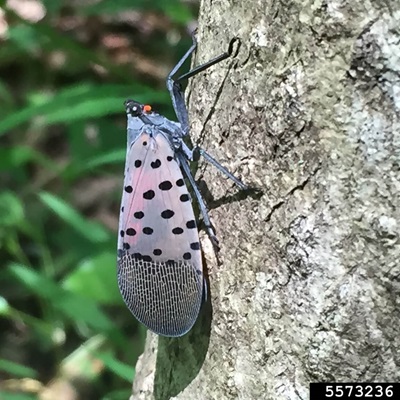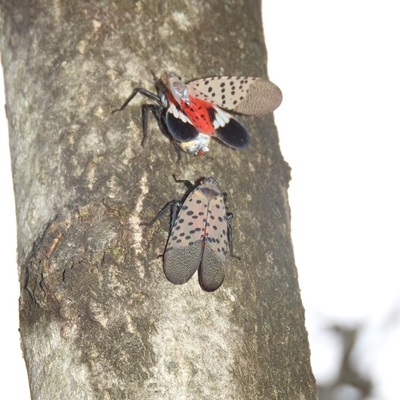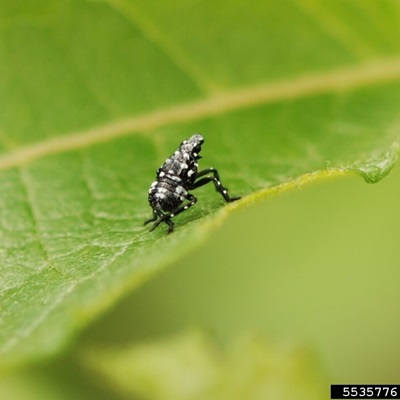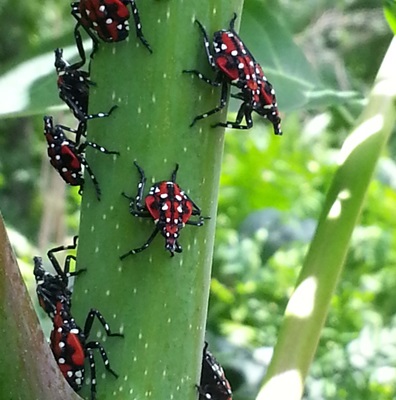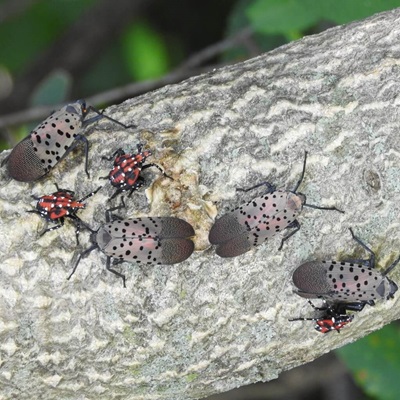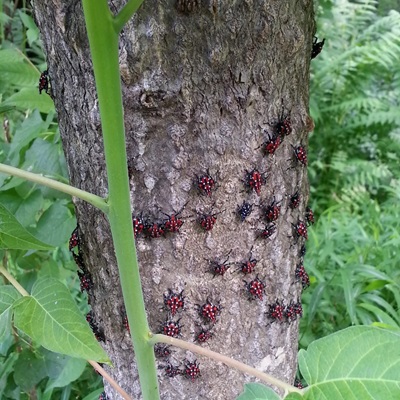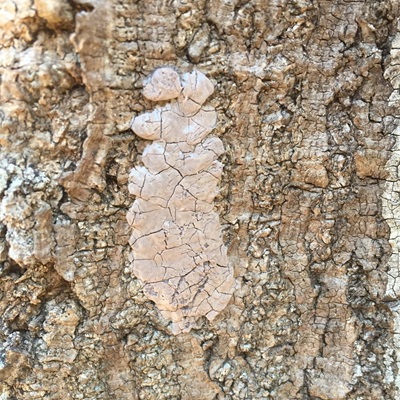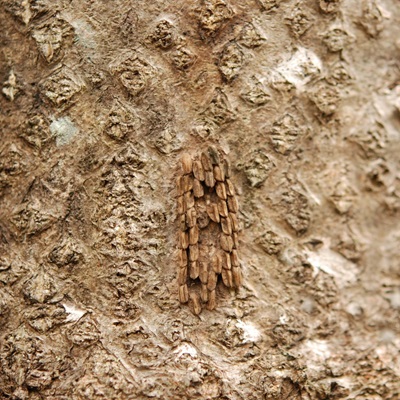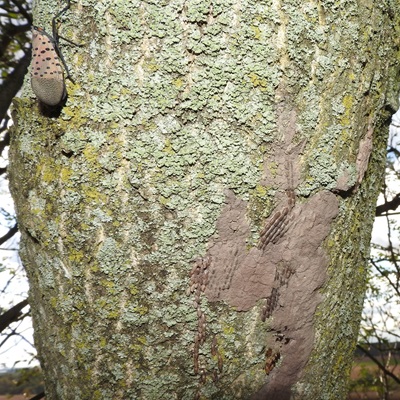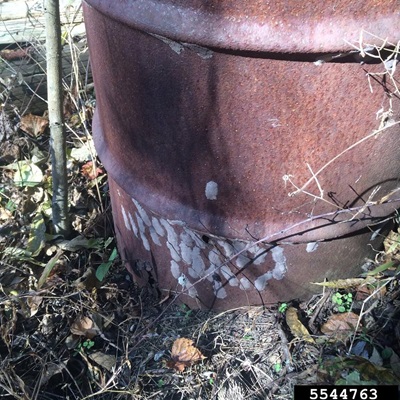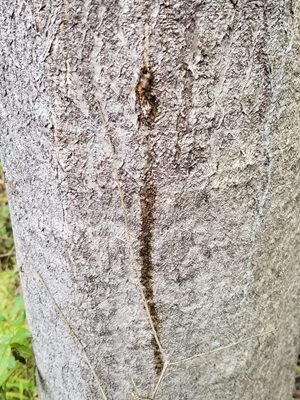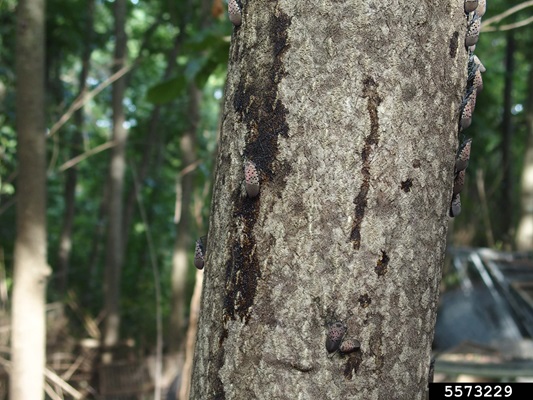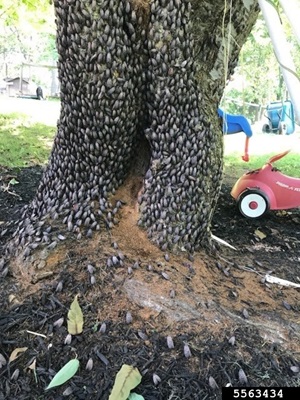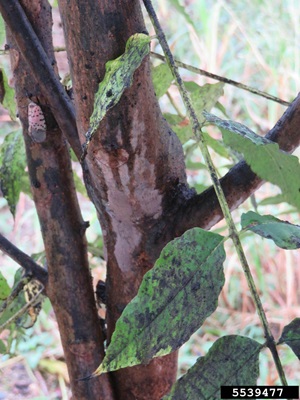Spotted Lanternfly
Lycorma delicatula

Background for Spotted Lanternfly Quarantine in Connecticut
The Connecticut Agricultural Experiment Station has issued a Quarantine Order with defined restricted areas for the exotic pest spotted lanternfly, Lycorma delicatula (SLF for short). This insect has been detected in Connecticut with established populations detected in Fairfield and New Haven Counties and single individuals intercepted in numerous towns. The spotted lanternfly is a new plant pest to the United States and represents a threat to Connecticut’s environment, residential areas, and agricultural interests, particularly forests, orchards, vineyards, and nurseries. The purpose of this quarantine is to slow the spread of SLF within the state and provide for certification of Connecticut businesses for movement of regulated articles out of state and help protect the economic interests of the state’s agricultural industries by suppressing, controlling or eradicating infestations of spotted lanternfly in regulated areas, and provide by inspection or compliance agreement methods to permit the movement of regulated articles not infested with spotted lanternfly. The Director of The Connecticut Agricultural Experiment Station by the authority of Connecticut General Statute Section 22-84 promulgated a Notice of Order of Quarantine to prevent and slow the further spread of this pest and sets forth: definitions, regulated articles, regulated areas, conditions of movement, violations and penalties, and special exemptions for research or cooperation with federal plant regulatory authorities. To read a summary of the public hearing held May 18, 2021 via Webex, click this link: Public Hearing
The quarantine order was renewed January 1, 2024, and will remain in effect until December 31, 2024, after which the quarantine may be renewed, rescinded by the Director, or replaced by the promulgation of regulations. View the quarantine order by clicking this link: Spotted Lanternfly Quarantine Order
To see a map of towns in CT with established SLF populations, click this link: SLF Regulated Areas Map
The SLF Compliance Agreement for Nursery and Plant Material
The SLF Compliance Agreement for Non-Plant Material
Identify Report News Management/Fact Sheets
What is the Spotted Lanternfly?
The spotted lanternfly Lycorma delicatula, (SLF) was first found in North America in Pennsylvania in late 2014. It is an exotic, invasive sap-feeding planthopper that has the potential to severely impact Connecticut’s agricultural crops, particularly apples, grapes, and hops, and ornamental trees. Spotted lanternfly adults feed on more than 70 species of plants. Its preferred host tree-of-heaven (Ailanthus altissima) is highly invasive and is abundant along highways, in urban areas, and along the edges of agricultural and industrial areas, where the spotted lanternfly could easily become established.
Why is it so important to stop an SLF invasion?
Approximately half of Connecticut's trees are threatened by spotted lanternfly invasion according to data from Connecticut's Department of Energy and Environmental Protection (DEEP). As spotted lanternfly nymphs and adults feed on the sap from trees and vines, the entire plant can become weakened because it cannot conduct photosynthesis as effectively. The excretions from these leaf-hopping insects encourage the growth of black sooty mold, thereby reducing photosynthesis. Agricultural crops will have reduced yields due to SLF feeding on fruit and generally weakening plants, if not completely destroying them (DEEP, 2020).
What should citizens do if they see a spotted lanternfly?
The public is urged to report potential sightings of this invasive pest. If you suspect you have found a SLF, snap a picture of it and fill out our reporting form by clicking this link:SLF Reporting Form. If you have other questions or comments please email ReportSLF@ct.gov. Please include in your email your contact information, any photos, and any other pertinent information. Permission by residents and businesses for state and federal plant inspectors to examine host trees on private property will be helpful in determining the extent of the infestation. All reports are confidential.
Management/Control Techniques
There are options to slow the spread of SLF, please see our factsheets below:
Spotted Lanternfly Management for Landscape Professionals
Spotted Lanternfly Management for Residents
Spotted Lanternfly Management for Vineyards
Spotted Lanternfly Checklist for Homeowners, Moving Companies/Industry
How to identify SLF
Adult spotted lanternflies are about one inch long and one half inch wide. Tan forewings that have black spots, while their signature colorful hindwings have lower red patches and upper black patches, separated with a white section in between. The red hindwings are mostly hidden unless the wings are spread. Adult SLF crawl, jump, or fly short distances. You will see adults from July to November.
|
Fig 1: Side view of adult SLF Emelie Swackhamer, Penn State University, Bugwood.org |
Fig 2: Top view of SLF adults with wings open and closed Lawrence Barringer, Pennsylvania Department of Agriculture, Bugwood.org |
Spotted lanternfly eggs hatch in the spring and early summer. Early instar nymphs are black in color with white spots; fourth instars nymphs are red with black and white spots. You will see nymphs from April to October.
|
Fig 3: Early stage nymph Lawrence Barringer, PDA, Bugwood.org |
Fig 4: Late stage nymph Victoria Smith, CAES |
|
Fig 5: SLF adults and late stage nymphs Richard Gardner, Bugwood.org |
Fig 6: Early and late stage nymphs Victoria Smith, CAES |
The spotted lanternfly eggs masses are laid on practically any surface including trees, stones, trash cans, side of a house, etc. during the fall. Egg masses are yellowish-brown in color, and most are covered with a gray, waxy coating prior to hatching (USDA, 2019). They may appear wet or sticky when fresh. You will see eggs from September to May.
|
Fig 7: Fresh egg mass Emelie Swackhamer, Penn State University, Bugwood.org |
Fig 8: Old egg mass Lawrence Barringer, PDA, Bugwood.org |
|
Fig 9: SLF adult and egg masses Richard Gardner, Bugwood.org |
Fig 10: SLF egg masses Lawrence Barringer, PDA, Bugwood.org |
Where is SLF found?
While tree-of-heaven, Ailanthus altissima, is a favored host tree, spotted lanternfly may be found on other trees including maple, walnut, and willow. It feeds on agricultural crops like apples, grapes, hops, as well as other fruit trees. It is native to China, India, and Vietnam. The adults tend to congregate on the tree-of-heaven and other host trees in the fall.
To identify Ailanthus altissima: view the tree-of-heaven identification fact sheet
Please check your vehicles for stowaways! Inspect your vehicles, trailers, and other items for SLF adults and egg masses when travelling through areas with known or suspected SLF populations. These insects are known to hitch a ride on vehicles and even clothing. Jump to: where SLF has been seen.
What will life be like when the spotted lanternfly comes to CT?
Spotted lanternfly is probably the most serious agricultural pest to hit US shores in a long time. The insect can kill a vineyard in a year or two. The SLF has real potential to become a “quality of life” pest. Spotted lanternfly is a sap-feeding planthopper that produces large amounts of liquid excrement called honeydew. In addition, the feeding of this insect also causes trees to weep sap, which combined with excreted honeydew creates conditions for sooty mold to grow. In infested areas, honeydew may rain down on surfaces, vehicles, and people, creating unpleasant situations. The honeydew is slippery on surfaces, and there have been reports of broken bones due to people falling down slick steps or slippery decks. The honeydew also may attract stinging bees or wasps. Often trees affected by SLF also have a fermented odor. In addition, other countries may refuse to accept US agricultural exports, if they feel that they may be contaminated with SLF.
|
Fig 11: Weeping sap from SLF feeding Gerda Magana, CAES |
Fig 12: SLF feeding damage Emelie Swackhamer, Penn State University, Bugwood.org |
|
Fig. 13: A backyard tree infested with SLF Lawrence Barringer, PDA, Bugwood.org |
Fig. 14 Sooty mold Kenneth R. Law, USDA APHIS PPQ, Bugwood.org |
Where has the SLF been seen?
Since first reported in 2014, spotted lanternfly has spread to multiple states, and interceptions of single adults have occurred throughout the northeast, including in Connecticut, in 2018 and 2019. In 2020, two small established populations of spotted lanternfly were found in Fairfield county in Connecticut. SLF has also been reported in New York, New Jersey, Delaware, Maryland, Virginia, and West Virginia.
To see a map of SLF sightings on Cornell CALS's page, click this link: Map of Confirmed SLF Sightings
To see the latest SLF sightings, check out The CAES's press releases by clicking this link: Press Releases
SLF fact sheets are available in PDF format:
In the episode, "CAES Programs, Services, and the Spotted Lanternfly," Dr. Victoria Smith from the CAES is interviewed about the spotted lanternfly and the Station. Click this link to watch on YouTube: https://youtu.be/OFvb_sZS8Gw
Videos and Webinars on SLF
Click this link to watch our SLF webinar on YouTube: https://youtu.be/6kT6bxrCWbM
More information about SLF can be found at the following websites:
https://extension.psu.edu/spotted-lanternfly
https://portal.ct.gov/DEEP/Forestry/Forest-Protection/Spotted-Lanternfly
https://www.aphis.usda.gov/aphis/resources/pests-diseases/hungry-pests/slf/spotted-lanternfly
References
Connecticut Department of Energy and Environmental Protection. (2020, September).
CT Spotted Lanternfly. Retrieved October 29, 2020, from
https://portal.ct.gov/DEEP/Forestry/Forest-Protection/Spotted-Lanternfly#trees
USDA, Animal and Plant Health Inspection Service, Plant Protection and Quarantine.
(August 2019). Pest Alert, Spotted Lanternfly (Lycorma delicatula).


